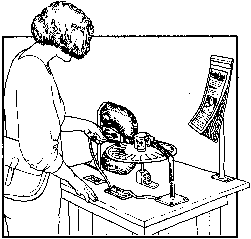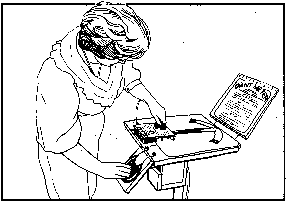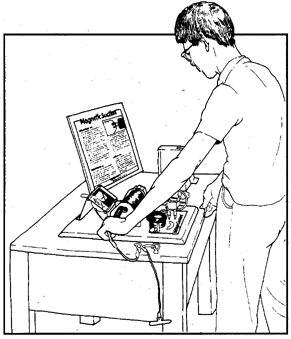|
|
Electricity, Motors and Meters |
Electricity, Motors and
Meters

When tiny, negatively charged particles called electrons flow through a wire, you have an electric current. When you bring an electric current and a magnet together, interesting things can happen. A magnet creates an invisible magnetic field that pushes against an electric current. What's more, the moving electrons also create a magnetic field that can interact with other magnets that are nearby. This interaction of magnets and moving electrons is what motors and meters are all about.
At each exhibit on this Pathway, try to find the permanent magnets and the path (or circuit) that the electrons follow. If you have any questions or problems, ask an orange-jacketed Explainer for help.
CIRCLES OF MAGNETISM
I The thick copper rod running through
the table top is really a giant wire. Press the button in
the table top to send an electric current through this wire.
Watch the way the compass needles move. Which direction do the compasses point
when the current direction is down? Motor
Effect Step on the floor mat to send an
electric current through the thick black wire. Watch the
wire fly up in the air. Try to push it down. You may be
surprised at how hard the green and red magnets force the
wire upward. How are the large magnets arranged. Is
the North pole on the righside or left side? What do you think would happend if the
magnets were reversed? Daisy Dyno
Hold the tip of the wire right at the
edge of the metal disk, beneath the magnet. Does the disk
spin? When you hold the wire at the edge of
the disk, electrons flow along the daisy's petals, from the
edge to the center of the daisy. When you hold the wire so
that the electrons flow beneath the permanent magnet, the
magnetic field pushes against the moving electrons, making
the disk spin. Which direction is the spin of the
disk? Stripped-Down
Motor Turn the switch to the right of the
battery so that it makes a connection between the two copper
bumps. Watch the copper wires spin. Electrons flow from the negative side
of the battery, through the motor, and then to the positive
side of the battery Trace the path of the moving electrons
with your finger, starting at the negative side of the
battery and following the wire up to the copper
plate. The copper plate is divided into four
sections. Each section connects to one end of a thick loop
of wire. The other end of the loop is attached to a
different section of the copper plate. The electrons flow
into the copper plate, through the loop, back to the copper
plate, down a wire, and through the switch to the positive
side of the battery. The magnet pushes on the moving
electrons that flow through the loop of wire, making the
motor spin. If you could, how could you reverse
the direction of this motor's spin? Giant
Meter This Giant Meter uses a coil of copper
wire and a magnetized needle to measure the flow of
electricity. Turn the knob to make electrons flow through
the coil of wire. The moving electrons make the coil of wire
into a magnet. This magnet, in turn, makes the iron bar into
a magnet, which pushes the magnetized meter needle to one
side. Magnetic
Suction Plug in the yellow plug and turn the
voltage all the way up. Put the iron bar into the mouth of
the coil and feel the magnetic force pull the bar
in. Unplug the yellow plug. Is there any
magnetic force now? Pull out the plug, reverse it, and
plug it in again. What happens? GENERATOR EFFECT Pull the handle back and forth very
quickly and the light bulb will light up. You're making
electric power for this bulb with nothing more than a coil
of wire and large magnets. How does the brightness
of the light change if you pull the handle slowly or
quickly?


![]()
![]()
![]()


![]()
![]()


![]()
![]()
Try to find a coil and an iron rod in the doorbell and in
the pinball flipper.

![]()
![]()